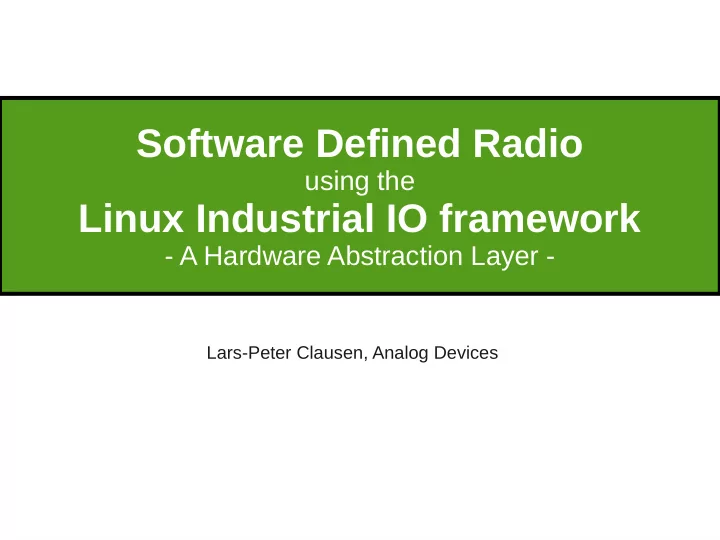

Software Defined Radio using the Linux Industrial IO framework - A Hardware Abstraction Layer - Lars-Peter Clausen, Analog Devices
What is IIO? ● Industrial Input/Output framework – Not really just for Industrial IO – All non-HID IO – ADC, DAC, light, accelerometer, gyro, magnetometer, humidity, temperature, rotation, angular momentum, ... ● In the upstream Linux kernel since v2.6.32 (2009) ● Moved out of staging/ in v3.5 (2012) ● ~200 IIO device drivers (v3.19) – Many drivers support multiple devices
Why use IIO for SDR? ● Provides hardware abstraction layer – Allows sharing of infrastructure – Allows developers to focus on the solution – Allows application re-use
Why use IIO for SDR? ● Kernel drivers have low-level access to hardware – MMIO – Interrupts ● IIO provides fast and efficient data transport – From device to application – From application to device – From device to network/storage (soon)
IIO Framework
IIO – Devices
IIO – Devices ● Main structure ● Typically corresponds to a physical hardware unit ● Represented as directories in sysfs
IIO – Attributes
IIO – Attributes ● Describe hardware capabilities ● Allow to configure hardware configuration ● Represented as files in sysfs
IIO – Channels
IIO – Channels ● Representation of a data channel ● Has direction, type, index and modifier ● Attributes provide additional information – scale, offset – Calibration data – Filters settings, hysteresis – ...
IIO – Buffers
IIO – Buffers ● Used for continuous data capture/transmit ● Channels can be enabled/disabled ● Channels specify their data layout ● /dev/iio:deviceX allows read()/write() access ● Configuration using sysfs files ● Support for different buffer implementations – Software FIFO – DMA Buffer – Device specific buffer
IIO – DMA buffer ● DMA is used to copy data from device to memory ● mmap() is used to make data available in application ● Allows low overhead high-speed data capture ● Data is grouped into chunks (called DMA blocks) to manage ownership – Either application or driver/hardware owns a block
IIO – DMA buffer
Example – AD-FMCOMMS2-EBZ ● Software Defined Radio platform ● AD9361 Agile integrated transceiver ● 200 kHz - 56 MHz sample rate ● Tunable from 70MHz to 6GHz ● Full-duplex ● MIMO, 2x RX and TX – Each channel a set of 12-bit I and Q data
Example – AD-FMCOMMS2-EBZ root@analog:/sys/bus/iio/devices# ls iio:device0 iio:device1 iio:device2 iio:device3 iio:device4 root@analog:/sys/bus/iio/devices# cat */name ad7291 ad9361-phy xadc cf-ad9361-dds-core-lpc cf-ad9361-lpc
Example – AD-FMCOMMS2-EBZ # ls iio\:device1/ in_voltage_filter_fir_en in_voltage_gain_control_mode_available in_voltage_rf_bandwidth in_voltage_rf_dc_offset_tracking_en in_voltage0_gain_control_mode in_voltage0_hardwaregain in_voltage0_rssi ... out_voltage_filter_fir_en out_voltage0_hardwaregain out_voltage0_rssi ... filter_fir_config ... in_temp0_input2
Example – AD-FMCOMMS2-EBZ # ls iio\:device4/ buffer in_voltage0_calibbias in_voltage0_calibscale in_voltage1_calibphase in_voltage_sampling_frequency in_voltage0_calibphase in_voltage1_calibbias in_voltage1_calibscale name scan_elements
Example – AD-FMCOMMS2-EBZ # ls iio\:device4/buffer/ enable length # ls iio\:device4/scan_elements/ in_voltage0_en in_voltage0_index in_voltage0_type in_voltage1_en in_voltage1_index in_voltage1_type
Plumbing Layer
libiio ● High level C interface to IIO ● Abstracts away low level details of IIO kernel ABI ● Transparently handles Low-Speed and High- Speed devices – Uses high speed interface when available
libiio ● Multiple backends – Local, directly using the IIO ABI – Network, uses network protocol to talk (remote) server (iiod) – Debug, fake devices for testing ● Bindings for python, C#, (C++) ● Cross platform (Linux, Windows)
iiod ● Multiplexing between multiple readers/writers ● Support for remote clients (via TCP/IP) ● Applications do not need system level privileges ● Transparent from the applications point of view
iiod & libiio
IIO Scope ● Capture and display data – Time domain, frequency domain, constellation, cross-correlation – Markers ● Plug-in system for easy configuration GUIs ● Custom math operations (experimental)
IIO Scope – Capture Window
IIO Scope – Plugins
GNU Radio Plugin ● Two base classes – IIO Sink, Transmit data to a IIO device – IIO Source, Receive data from a IIO device ● Can select device and inputs/outputs ● Built-in support for Interpolation/Decimation
GNU Radio Plugin ● Possible to subclass IIOSink/IIOSource – e.g. to implement device specific specialization ● GUI ● Setting attributes – Current examples: ● FMCOMMS2 Sink ● FMCOMMS2 Source
Gnu Radio Plugin
Demo ● FM radio receiver
Demo Setup ● AD-FMCOMMS3-EBZ (AD9361) ● Zed Board (ZYNQ FPGA) running Linux with AD9361 IIO driver and IIOD ● Laptop running GNU Radio with the IIO plugin ● Laptop connected to ZED board via Ethernet
Demo Flow ● Capture data in the FM radio spectrum ● Stream it from the ZED board to the Laptop ● Decode the FM radio stream in GNU radio ● Playback FM radio on the Laptops speaker
Demo GNU Radio Canvas
Live Demo
Further information https://github.com/orgs/analogdevicesinc ● https://github.com/analogdevicesinc/libiio – https://github.com/analogdevicesinc/iio-oscilloscope – https://github.com/analogdevicesinc/linux – https://github.com/analogdevicesinc/gnuradio – http://wiki.analog.com/resources/tools-software/linux-software/libiio_internals ● http://analogdevicesinc.github.io/libiio/ ● http://wiki.analog.com/resources/tools-software/linux-software/iio_oscilloscope ● https://wiki.analog.com/resources/tools-software/linux-software/gnuradio ● https://archive.fosdem.org/2012/schedule/event/iio.html ● http://events.linuxfoundation.org/sites/events/files/slides/iio_high_speed.pdf ●
Q/A
IIO – Device Graph (Future) ● Use media controller framework to expose device topology – Allows userspace to auto-discover processing pipeline – Better support for standard components
IIO – Zero Copy (Future) ● Use vmsplice and friends to provide zero copy – High-speed network streaming without CPU interaction – High-speed disk writes/reads without CPU interaction
Recommend
More recommend